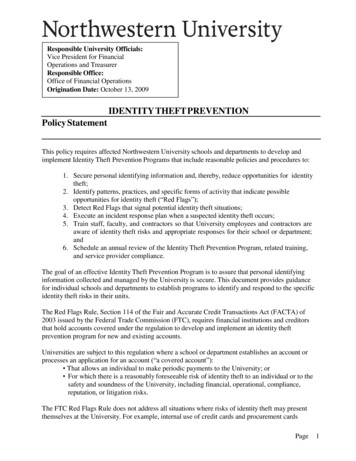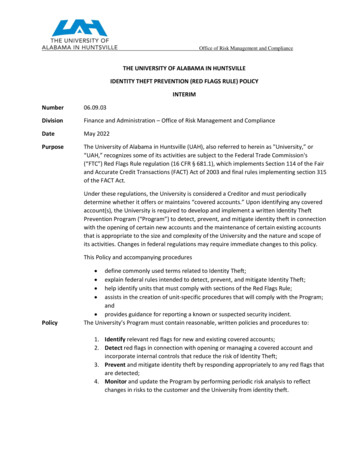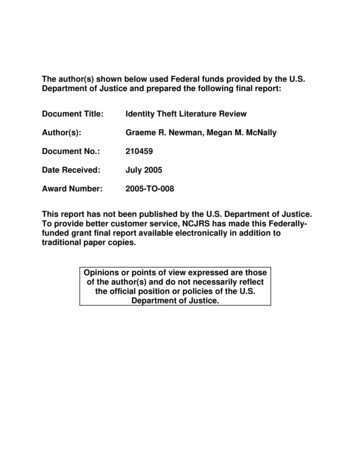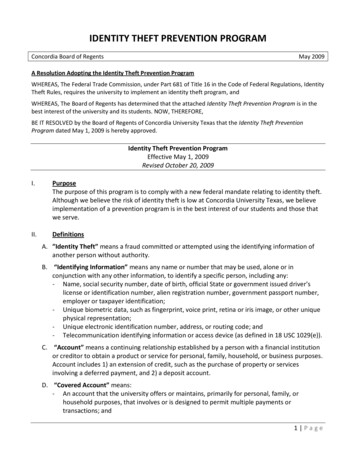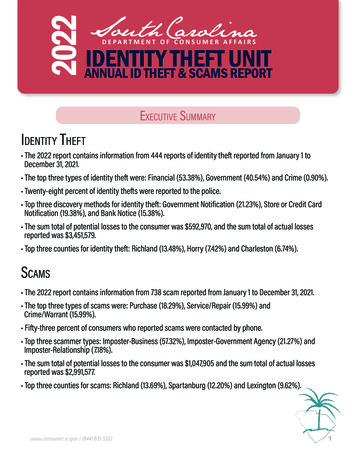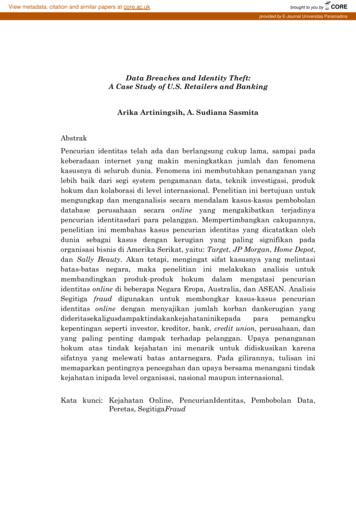
Transcription
View metadata, citation and similar papers at core.ac.ukbrought to you byCOREprovided by E-Journal Universitas ParamadinaData Breaches and Identity Theft:A Case Study of U.S. Retailers and BankingArika Artiningsih, A. Sudiana SasmitaAbstrakPencurian identitas telah ada dan berlangsung cukup lama, sampai padakeberadaan internet yang makin meningkatkan jumlah dan fenomenakasusnya di seluruh dunia. Fenomena ini membutuhkan penanganan yanglebih baik dari segi system pengamanan data, teknik investigasi, produkhokum dan kolaborasi di level internasional. Penelitian ini bertujuan untukmengungkap dan menganalisis secara mendalam kasus-kasus pembobolandatabase perusahaan secara online yang mengakibatkan terjadinyapencurian identitasdari para pelanggan. Mempertimbangkan cakupannya,penelitian ini membahas kasus pencurian identitas yang dicatatkan olehdunia sebagai kasus dengan kerugian yang paling signifikan padaorganisasi bisnis di Amerika Serikat, yaitu: Target, JP Morgan, Home Depot,dan Sally Beauty. Akan tetapi, mengingat sifat kasusnya yang melintasibatas-batas negara, maka penelitian ini melakukan analisis untukmembandingkan produk-produk hokum dalam mengatasi pencurianidentitas online di beberapa Negara Eropa, Australia, dan ASEAN. AnalisisSegitiga fraud digunakan untuk membongkar kasus-kasus pencurianidentitas online dengan menyajikan jumlah korban dankerugian adaparapemangkukepentingan seperti investor, kreditor, bank, credit union, perusahaan, danyang paling penting dampak terhadap pelanggan. Upaya penangananhokum atas tindak kejahatan ini menarik untuk didiskusikan karenasifatnya yang melewati batas antarnegara. Pada gilirannya, tulisan inimemaparkan pentingnya pencegahan dan upaya bersama menangani tindakkejahatan inipada level organisasi, nasional maupun internasional.Kata kunci: Kejahatan Online, PencurianIdentitas, Pembobolan Data,Peretas, SegitigaFraud
Arika Artiningsih, A. Sudiana SasmitaData Breaches and Identity Theft:A Case Study of U.S. Retailers and BankingAbstractThe objective of this paper is to evaluate the cases of online data breach andidentity theft. According to Brodtmann (2011), identity theft has existed forlong of time and the proportion has increased since the Internet has made thecustomer’s personal information available online. This phenomenon hascalled better security, advance investigation techniques, law enforcement, andinternational collaboration. All the cases discussed would be limited forbusiness organisations in the United States (U.S.), which are Target, JPMorgan, Home Depot and Sally Beauty. These cases are the most significantonline identity theft recently occurred in the world. However, comparison oflegislative reforms that addressed would be done for U.S., Europe, Australiaand ASEAN due to the nature of the cybercrime that crossing the nationalboundaries. Fraud triangle would be use as the analysis tools. Victims anddamages would be presented to show the consequences of this fraud to thestakeholders, including investors, creditors, community banks and creditunion, the business itself and importantly the customers. Prosecution andlegislative discussion would be provided to show how the governments overthe world react to the issue of online data breach and identity theft thatcrossing national boundaries. Lastly but not least, recommendation toprevent and prosecute this kind of fraud would be given in the three levels,which are within the organisation, national level and international level.Keyword: Cybercrime, Online Identity Theft, Online Data Breach, Hackers,Fraud Triangle1477
Jurnal Universitas Paramadina Vol. 13 Tahun 2016IntroductionFirst of all, identity theft has occurred “when a party acquires, transfers,possesses, or uses personal information of a natural or legal person in anunauthorised manner, with the intent to commit, or in connection with,fraud or other crimes” (Organization for Economic Co-operation andDevelopment 2008, p.3). There are two ways to commit this act, online andoffline (Jamieson et al. 2012, p.382). When identity theft has correlated withthe misuse of computer, computer crime and computer-related crime becausethe Internet facilitate them, it called as online identity theft, for example isthe case of hackers who stole someone‟s personal information through onlinedata breach. In contrast, when the identity theft have committed throughwallet theft, mail redirection and dumpster diving, it categorised as offlineidentity theft. This paperwould address the online identity theft caused byonline data breaches in several business organisations, which are Target, JPMorgan, Home Depot and Sally Beauty. As cited in Roberds and Schreft(2009, p. 920), a data breach defined as an unauthorized access of personaldata recorded by organization has promoted identity theft. Phishing,farming, malware and hacking are common methods that have been used tocommit this action (Almerdas 2014, pp.84-6).All the cases discussed have been limited for business organisationsin the United States (U.S.). However, comparison of legislative reforms thataddressed would be done for U.S., Europe, Australia and ASEAN due to thenature of the cybercrime that crossing the national boundaries. Moreover,these countries have been the main targets of cybercriminals. As evidence ofthis, even though there is no such case happened in Australia, the AttorneyGeneral‟s Department reported that identity crime costs Australia up to 1.6billion each year, with 900 million out of that number was contributed byindividuals lost through identity theft, credit card fraud and scams(Australian Federal Police 2015).Then, looking to the U.S., the PonemonInstitute (2014) reports that the organization‟s cost for data breach and1478
Arika Artiningsih, A. Sudiana SasmitaData Breaches and Identity Theft:A Case Study of U.S. Retailers and Bankingidentity theft is USD 3,900,000 while the damage for organisation‟sreputation and brand could be up to USD 330,000,000. The discussion wouldbe started by the description of the cases, followed by the analysis,recommendation and conclusion.Case DescriptionFirst of all, during the period of 2013-2014, U.S. have been shocked withseveral data breaches experienced by big retailers, which are: Target, HomeDepot, Sally Beauty and one of the biggest banks, J.P. Morgan. It was thetime when the nightmare of credit cards‟ holder have been started since theirpersonal information and their financial information have been exposed,result in vulnerability that they might become the victims of identity fraudin the future.Target data breach was the biggest identity theft in 2013. It wasstarted in 27 November 2013 when the hacker put a malware named asRAM Scraper to its Point-of-Sales (PoS) terminal to copy the customer‟spersonal information during the short moment when it was unencrypted andsent from PoS terminal to PoS register itself (Zorabedian 2014). This identitytheft was occurred for two weeks before Target discovered it in 15 December2015. This fraud has occurred because Target ignored the red flags given byits security team that spotted unusual activities in the payment system(Riley et al. 2014). Target‟s customers have not been informed yet until fourdays later when Target publicly admitted that their database has beencompromised and 40 million customers‟ personal and financial informationhave been exposed, including names, credit card numbers, its expirationdate, mailing addresses and emails. Later, in 10 January 2014, Targetannounced that additional 70 million customers‟ information has been stolen(Clark 2014). Target has missed its opportunities to prevent the data breachby ignoring the red flags given by its professional security team(Congressional Research Service (CRS) 2015, p.2-4).Similar fraud has occurred for the Home Depot and Sally Beauty.1479
Jurnal Universitas Paramadina Vol. 13 Tahun 2016Hackers have infiltrated the Home Depot network and copy the customers‟information from April 2014 to September 2014 when it was discovered. Atthat moment, 56 Million Credit Card payment details and 53 millioncustomers‟ emails have been exposed. Meanwhile, in March 2014, Sallybeauty also announced that 25,000 customers‟ records including paymentcard information has been exposed. The fraudsters of this breach weresuspected from the same gang of Russian and Ukrainian hackers. Asevidence of this, credit cards stolen from Sally beauty has been sold inRescator[dot]cc, the same shop where the cards from Home Depot and Targethave been sold. In addition, it was sold under batches named as “AmericanSanctions” and “European Sanction” which interpreted as a revenge forsanction given to Russia KrebsOnSecurity (2015).The biggest identity theft recorded was J.P. Morgan. According toUnited States Securities and Exchange Commission Form 8-K (2014), J.P.Morgan reported lost of 76 million households and 7 million small businessespersonal information including names, addresses, phone numbers, emailaddresses, and “internal JPMorgan Chase information relating to suchusers”. The hackers were suspected from Russia also but different gang withthe hackers that stole from Target, the Home Depot and Sally Beauty. Asreported by Riley and Robertson (2014), the hackers have succeeded to enterthe layers of sophisticated security system that seem far beyond thecapability of ordinary criminal hackers. They added that FBI was involved inthe investigation because of size of the loss and because the fraud hasoccurred when the tension between West and Russia increased. Appendix Aprovides summary of the cases in a table.Research MethodologyThe research method employed is called case study. This method allows theexploration and understanding of complex issues through reports of paststudies. In addition, this method enable researcher to go beyond thequantitative method and understand the behavioral environments through1480
Arika Artiningsih, A. Sudiana SasmitaData Breaches and Identity Theft:A Case Study of U.S. Retailers and Bankingthe actor‟s point of view (Zainal 2007, p.2). As a result, it could be used as atool forreconstruction and analysis of the cases under investigation(Tellis,1997).Therefore, firstly, this research conducted to what extent existingresearch has progressed towards clarifying a particular problem relating todata breaches and identity theft. Secondly,interrelation, contradictions, gapsand inconsistencies among cases were identified using fraud triangleanalysis to figure out the reasons behind these fraudulent acts. Thirdly, thediscussion would be extended to the point in which the world reacts toovercome this kind of fraud. Lastly,a recommendationwould provide to helpthe world prevent and overcome this problem.Case AnalysisThis section would analyse the cases described above using fraud trianglefollowed by the description about the number of victims and damages. Then,it would be ended with the discussion about prosecution and legislationdiscussion.Fraud Triangle AnalysisSeveral factors behind the reason of the hackers to commit a data breach inorder to steal the customers‟ personal information could be analysed usingthe elements of fraud triangle developed by Donald Cressey, which consistsof perceived pressures, opportunities and rationalisation. Albrecht (2015)argued that anonymity of the hackers has made it difficult to discover thepressures and rationalisation. However, by using information combined fromthe investigations and previous studies we might be able to identify theseelements.As described before, several evidences indicated that the hackerswere from Russia and. Blau (2004) argued that after the financial crisis in1998, many people in Russia have lost their job, including professional suchas computer programmers and business owners. The severe impacts are1481
Jurnal Universitas Paramadina Vol. 13 Tahun 2016persisting till today when the students who are excellent in algorithms andphysics are difficult to find a job. Being a hacker offer them a solution tomake money. Russia is as “a happy heaven” and “perfect breeding place” forhackers since people there are “overeducated and underemployment” (Blau2004). This was proved when two hackers, 23 and 17 years old respectively,confessed that they were the creator of malware used to breach Target andHome Depot. The economics condition there might become worse after theU.S. and European economic sanction. As a result, we might conclude thatthe need of money for a living could be the main perceived pressure. Anotherpressure is greed since according to KrebsOnSecurity (2014), he hackersobtained 53.7 million by selling two million credit cards number of Targetsince each card was priced between18.00 and 35.7 dollar. Nevertheless, twomillion were only small amount of out of the total credit cards number thatstolen. This amount was definitely easy money for the hackers. As Capers(2015) argued “identity is now a form of currency, and the consequences ofthis development are unfolding in interesting and often unpredictable ways”.Perceived rationalisation would be the interesting element todiscuss. A research conducted by Dremliuga (2014, pp.158-9) revealed that inRussia, hackers have been viewed as researchers instead of criminalsbecause of the easy acceptance of hacker‟s ideology. People in Russia believethat every single data should be for all humanity and the world of freecomputer information would be a better world. As a result, hackers believedthat they were doing a good thing by helping people to provide free access toinformation. In addition Gostev, a security expert from Moscow-basedKaspersky cited in Blau (2004) stated that "I know of no hackers beingimprisoned in Russia" and “They seem to be more interested in protectingnational security". This makes people believe that hackers are not dangerousand then, even though Russia considers hacking as illegal and they haveRussian Criminal code about criminal liability for illegal access (Article 272)and spreading of malicious software (Article 273), judge would choose softpenalty (Dremliuga 2014, p.160).1482
Arika Artiningsih, A. Sudiana SasmitaData Breaches and Identity Theft:A Case Study of U.S. Retailers and BankingThese were enough to rationalize that breaching a company‟sdatabase to steal and then sell the customer‟s personal information were notsomething wrong. From their point of view, they have helped to create abetter world with no information restriction. By doing this they might beproud and feel like a hero for Russia because the conflict between Russia andU.S. They might be not afraid to be caught also since they believed that theircountry would protect them in the same way as they protecting the nationalsecurity. As an evidence for this, FBI investigation in J.P. Morgan casediscovered a fact that no indication that the stolen information was used tobenefit them financially (Masi 2014). Meanwhile, for the hacker gang thatsold Target, the Home Depot and Beauty Sally credit cards‟ number forfinancial benefit, they might believe that they do not deceive the customerssince they were only sold the cards that were used to steal the money.Lastly, they might believe that those organizations deserved for it sincethere were weaknesses in the security system implemented. From thehacker‟s point of view, the weaknesses of security system allowed them toenter and then it was not their faults if the customers‟ information wasexposed.Next, perceived opportunities came from the loopholes in securitysystem that allow the hackers to break in the system. In addition, ignoranceof the red flags and employees‟ security careless gave them opportunity tosteal more. Kirk (2014) reported that hackers for Target and the HomeDepot using the login credential from third party to enter their securitysystem and it was suspected that they came from the same gang of hackers.For the Target data breach, the hackers were using credential loginbelonging from the heating and ventilation contractor, Fazio MechanicalServices and for the Home Depot, they used login credential from one of theirvendors. When they entered to the system, they compromised the PoSsystem. These were slightly different with J.P. Morgan and Beauty Sallycases since in these cases they used credentials login from people within thecompany. In the J.P. Morgan case, the hackers used one of the employees‟1483
Jurnal Universitas Paramadina Vol. 13 Tahun 2016user name and password to enter the web-development server that openedthe way to the bank‟s main network (Goldstein et al. 2014). In addition, thebank has neglected to upgrade one of its network servers by not using twofactor authentication (Goldstein et al. 2014). Meanwhile, for Sally ntiallogin.KrebsOnSecurity (2015) reported its interview with Blake Curlovic, anapplication support analyst of Sally Beauty who said, “This guy was notexactly security savvy. When we got his laptop back in, we saw that it hadhis username and password taped to the front of it”.In the Target case, ignoring the red flags has created moreopportunity. At that moment, the Target has used FireEYe (FEYE), aprofessional security team used by Pentagon and CIA. FEYE has given analert to Target when the spot the Malware in the PoS system in 30November 2013 before the Hackers moved the data to the servers out of thecountry. However, Target ignored this alert (Riley et al. 2014). Lastly,because data breach and online identity theft were falling in the category ofcybercrime, it was difficult to prosecute due to the national boundaryprotection. In these cases, the Hackers were in Russia that does not haveextradition agreement with U.S. As a result, the U.S. law enforcementscannot catch and prosecute the hackers. In addition, the anonymity and lackphysical contact would give the fraudsters more opportunity to commit theaction since it was difficult to track their identities.The summary of how they got opportunities and scheme used toenter the companies‟ system could bee seen in Appendix B.Victims and DamagesThe data breach consequences are not for the company only, but also for itsstakeholders including investors, creditors, community banks and creditunion. Equally important, the impact forcustomers.In the last quarter of 2013 and the first quarter of 2014, after thedata breach, Target‟s net income decreased up to 46% compared to the1484
Arika Artiningsih, A. Sudiana SasmitaData Breaches and Identity Theft:A Case Study of U.S. Retailers and Bankingprevious quarter and its shares‟ price also declined by 9%. Similar financiallosses also suffered by the Home Depot, Sally Beauty and J.P. Morgan. Inaddition, the companies might lose its reputation and customers‟ trust.Target has faced 90 lawsuits while the Home Depot has faced 44 lawsuits.The customers believe that that the companies should be able to do more inprotecting their personal information.For the employees, the decrease of revenue might result inpermanent or temporary lay off. In the first quarter 2014, Target closed 133stores in Canada, laid off 1,700 employees and 1,400 positions were unfilleddue to the significant decrease of revenue (Bukaty 2015).The communitybanks also suffered losses since they need to reissue the credit cards. It costthem 200 million to reissue Target‟s customers credit cards and spent 90million to reissue Home Depot‟s credit cards. Lastly, customers suffered themost since they might become the victim of identity fraud in the future. Oncethey become the victim of identity fraud, it would take so many effort, costsand time to get their identity and reputation back. For details and summaryof financial losses caused by this data breaches, see Appendix C.Prosecution and Legislative DiscussionThe U.S. Assistant Attorney General Caldwell cited in The United StatesDepartment of Justice (DOJ) (2015) said “Cyber criminals concealthemselves in one country and steal information located in another country,impacting victims around the world” and “Hackers often take advantage ofinternational borders and differences in legal systems, hoping to evadeextradition to face justice”. As a result, lacks of international collaborationin the form of extradition agreement and international treaty wouldchallenge the investigation.After more than a year investigation, no one has been charged fordata breach in Target, Home Depot, Sally Beauty and J.P. Morgan.Anonymity, national boundary and the absence of extradition agreementbetween Russia and U.S. have made the investigation process getting1485
Jurnal Universitas Paramadina Vol. 13 Tahun 2016harder. RhinatShabayev (23) and Sergey Taraspov (17) have admitted thatthey were the creator of malware used in Target and The Home Depot(Selvan 2014). However, the U.S. could neither do further investigation norprosecute them since they were living beyond the U.S. national boundaryThe U.S. might be able to prosecute the hackers if they were living ina country that signed extradition agreement with the U.S. For an example, aRussian national, Vladimir Drinkman (34) who stole 160 million credit cardnumbers -the biggest data breach and identity theft that ever prosecuted inthe U.S. after the prosecution of Albert Gonzales in 2010 for the same casehas been extradited to U.S. from Netherland where he was arrested (DOJ2015). A recent case is the case of ArditFerizi(21) who had arrested inMalaysia in October 2015 and extradited to the U.S. for 20 years sentencedin January 2016 because he stole information (names, email, addresses,passwords, locations and phone numbers) for about 1,350 military personneland federal staff and then sold itto ISIS as a hit list (BBC, 2016). DOJ ascited in BBC (2016) said that the case is the first kind and represented of“the nexus of the terror and cyber-threats”. The latest case shows thatidentity theft and data breach is serious problem that could not only putsomeone‟s money in danger but also someone‟s life in danger.Target and J.P. Morgan cases have triggered discussion in the U.S.about how to strengthen the national law in order to overcome the spurred ofdata breach that leads to online identity theft. As stated by CRS (2015,pp.19-23) the U.S.Congress has discussed about the need of federalnotification requirement for data security breaches. Similar discussion alsohas been done in Europe and Australia. The different rules of Data BreachNotification Law in the U.S., Europe, and Australia and the proposal toimprove it could be seen in the Appendix D.In addition, the U.S. Congress also discussed the possibility of givingmore authority to Federal Trade Commission‟s (FCT‟s) who has mainresponsibility to help the victims of identity theft to penalize business thatfails to adequately protect the customers‟ personal information (CRS 2015,1486
Arika Artiningsih, A. Sudiana SasmitaData Breaches and Identity Theft:A Case Study of U.S. Retailers and Bankingpp.23-26). These reflect the need to strengthen the cybercrime related law toovercome the spurred of data breach that lead to identity theft.Meanwhile, Australia has amendment its Commonwealth CriminalCode by enacting The Law and Justice Legislation Amendment IdentityCrimes and Other Measures) Act 2010 (Cth) (Identity Crimes Act) on 2March 2011 because they believe that the Commonwealth Criminal Codewas not able to adequately facilitate the various form of identity theft due tothe use of technology and internet that facilitate this action (Paphazy 2011,pp.28-9).Then, in Europe, there is Europe‟s Convention on Cybercrime whichalso the only one of international treaty that addresses this issue. Othercountries such as U.S., Canada, Japan, and Australia have signed this treatyalso and U.S. has ratified it. (Jamieson et al. 2012, p.392).Looking at another region, ASEAN which mostly consist of developedcountry has commitment to develop and adopt best practices and lawsrelated to data protection in order to support and harmonize legalinfrastructure for e-commerce in the Roadmap for Integration of e-ASEANSector (Chow and Redfearn2016). Singapore, Malaysia and Philippines hadshowed their commitment in data protection laws whereas Indonesia,Vietnam and Myanmar put data protection only in the part of electronictransaction law. Recently Indonesia has purposed a bill of data protectionlaw. Chow and Redfearn (2016) also said thay if this bill is approved by thehouse of representative (Dewan Perwakilan Rakyat, DPR) then Indonesianeed to reconcile this data protection law with the previous Act andgovernment regulation related on it.RecommendationRecommendation would be given in the three levels, which are within theorganisation, national level and international level.First, within the organisation, the company should update andmaintain their security system periodically to minimise the loops in the1487
Jurnal Universitas Paramadina Vol. 13 Tahun 2016system. Then, organisation policy should be made for both, prevention anddetection of fraud. Security and fraud awareness training should be done tomake the employees aware if there were suspicious activities in the systemand keep them safe when using the Internet at home or at the office.Standard Operational Procedure (SOP) to follow up the alerts and red flagsshould be developed also. In the case of Target we might see that hiring thebest professional security team was useless if there was no action to followup the alerts. Segregation of duties should be created also between peoplewho responsible for maintaining security system, servers and informationassets. Lastly, organisation should consider the customer‟s information thatthey should and should not keep. Target has been criticised because theykept the credit card‟s PIN.In the national level, the government should set a standard ofminimum acceptable security system for business. In addition, penaltiesshould be given for business organisation that fails to notify the customerswithout delay after the data breach. These are important for both, givingmore protection to customers and preventing them to suffer more losses.Lastly, because of the nature of cybercrime was crossing the nationalboundary, more international treaty and collaboration between country areneeded since domestic law may be not able to go beyond the nationalboundary. The extradition of Vladimir Drinkman from Netherland to theU.S. has proved that collaboration was needed to prosecute the cybercriminals.ConclusionFrom the discussion above, current scheme to commit identity theft has beenidentified, which was through online data breaches. This was the easiest wayto steal personal and financial information in a huge scale. In addition, itwas preferable for the fraudster because they got anonymity and nationalboundary protection. Repercussion of action has happened for Home Depot,1488
Arika Artiningsih, A. Sudiana SasmitaData Breaches and Identity Theft:A Case Study of U.S. Retailers and BankingSally Beauty and J.P. Morgan after the hackers successfully breached andstole customers‟ information from Target.These cases happened because the hackers have exploited theloopholes in organisation‟s security system. These could be in the form ofout-dated security system such as in the case of J.P. Morgan that fail toimplemented two-factors authentication, ignorance of alerts (red flags) suchas in the case of Target or lack of security awareness trainings for employeesand third parties that made them being the victims of social engineering bygiving their credentials to the hackers.Perceived pressures, rationalisations and opportunities of thehackers were similar because they came from the same country and thenhad similar background and motivation. The perceived pressures were theneed for money and greed, the perceived opportunity were securitysystem‟sand internal control weaknesses as well as the ignorance of redflags. Lastly, the rationalisations were hackers‟ ideology and not deceivingthe customers since they were only selling the cards used to steal thecustomers‟ money.To overcome the spurred of this problem, organisation need to investmore in the security system as well as develop an organisation policy tosupport the security system. Fraud prevention and detection system such asan effective internal control system, fraud awareness training and whistleblowing mechanism are necessary to prevent these types of frauds fromhappening again in the future. Most importantly, business should investmore on the IT security system to protect their organisation from internaland external intruders, due to the heavy reliance of their process on theonline systems.Last but not least, in the country level, international treatyand joint collaboration are needed to prosecute the fraudsters who hidingbehind the national protection boundary. As a result, extradition agreementis absolutely needed to prosecute the hackers.1489
Jurnal Universitas Paramadina Vol. 13 Tahun 2016ReferencesAlbrecht, WS, Albrecht, CO, Albrecht, CC &Zimbelman, MF 2015, FraudExamination, 5thedn,Almerdas, S 2014, „The criminalisation of identity theft under the SaudiAnti-Cybercrime Law 2007‟, Journal of International CommercialLaw and Technology, vol. 9, no.2, Spring, pp.80-93, viewed 1 April2015, LegalTrac database.Anonym 2016, „Hacker who aided IS sentenced to 20 years in US prison‟BBC News, 23 September 2016, viewed 18 November 2016 http://www.bbc.com/news/world-us-canada-37458168 .Blau J 2004, „Russia - a happy haven for hackers, Computer Weekly‟,ComputerWeekly,31May,viewed10May2015, py-havenfor-hackers .Bukaty, RF 2015, „Target Offers 10 Million Settlement in Data BreachLawsuit‟, The Two Way, 19 March, viewed 4 June2015, a-breach-lawsuit .Capers, Z 2015, „How We Innocently Give Away Our Data‟, ACFE
Data Breaches and Identity Theft: A Case Study of U.S. Retailers and Banking 1477 Abstract The objective of this paper is to evaluate the cases of online data breach and identity theft. According to Brodtmann (2011), identity theft has existed for long of time and the proportion has increased since the Internet has made the






